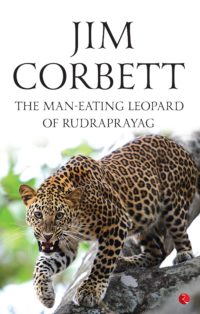WRITING STYLE: 4/5
ENTERTAINMENT QUOTIENT: 3.5/5
HISTORICAL VALUE: 3.5/5
The Man-Eating Leopard of Rudraprayag is the true account of one of Jim Corbett’s many adventures with man-eating animals.
This particular one is about a Leopard that lived in Rudraprayag, a small town in the state of Uttarakhand in India. It is situated on the confluence of rivers Alaknanda and Mandakini before they go south to join the river Bhagirathi and form the famous river Ganga.
It is located at a distance of 86km from the famous Hindu holy town of Kedarnath and is therefore frequented by Hindu travellers from all over the world.
The Man-Eater of this town spread its man-hunting activities over an area of 500 sq. miles and continued them for 8 years (1918-1926) before it was finally killed by Jim Corbett.
Between these eight years, the man-eater had claimed 125 lives officially, but according to many the unofficial estimates, it might be much higher.
The Man-Eating Leopard of Rudraprayag begins with an introduction of the man-eater when Jim first comes to learn about it and decides to go and hunt it.
The book then goes on to describe each of his attempts at getting the man-eater. He tries everything from poisons to gin-traps to goats as bait and fails an innumerable number of times.
Finally, he is so disappointed with his failure that he decides to leave the town for a few months. After staying away for a few months and having gained his newfound confidence he decides to come back and begin with a fresh start.
However, his luck fails him here as well and after struggling for a long time he decides to quit. It is on his last day in Rudraprayag when he shoots the leopard fatally and ends its long streak of terror.
The book is written in an interesting and informative manner.
Jim Corbett begins with a very creepy and petrifying introduction of the Man-Eater by describing its kills and the fear which it had instilled in the minds of the citizens of Rudraprayag and the passing pilgrims bound for Kedarnath.
Also, for somebody who is reading this kind of a book for the first time, the descriptions are quite vivid and the concepts are explained in great detail.
The best part of the book is the descriptions of man-eater’s notorious cunning in escaping death so smartly, every time an attempt is made by the author.
Corbett’s near-death encounters with the man-eater are also quite scary and petrifying.
Though Jim Corbett was a hunter, his talent at writing a gripping book such as this, is commendable.
He is extremely emotional and has a wonderful ability to portray his emotions. The way he describes his admiration of the Gorkhas, their land, the love for India and its people, the appreciation of the beauty of Himalayas as it leaves him spellbound, is just adorable.
Just to give you an essence of the importance of this hunt, an annual fair is held in the town of Rudraprayag to this day, almost 90 years after the incident, to celebrate the killing of the beast and even to this day Jim Corbett is still hailed as a “Sadhu” by many there.
The Man-Eating Leopard of Rudraprayag is a must-read for anyone who is interested in history, jungles or animals because the book and the author are an indispensable part of Indian history.
